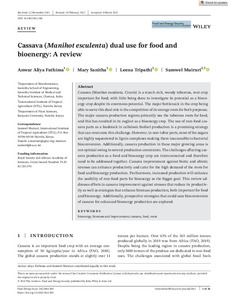| dc.contributor.author | Fathima, A.A. |
| dc.contributor.author | Sanitha, M. |
| dc.contributor.author | Tripathi, L. |
| dc.contributor.author | Muiruri, K.S. |
| dc.date.accessioned | 2022-05-23T14:44:14Z |
| dc.date.available | 2022-05-23T14:44:14Z |
| dc.date.issued | 2022 |
| dc.identifier.citation | Fathima, A.A., Sanitha, M., Tripathi, L. & Muiruri, S. (2022). Cassava (Manihot esculenta) dual use for food and bioenergy: A review. Food and Energy Security, e380, 1-26. |
| dc.identifier.issn | 2048-3694 |
| dc.identifier.uri | https://hdl.handle.net/20.500.12478/7481 |
| dc.description.abstract | Cassava (Manihot esculenta. Crantz) is a starch-rich, woody tuberous, root crop important for food, with little being done to investigate its potential as a bioenergy crop despite its enormous potential. The major bottleneck in the crop being able to serve this dual role is the competition of its storage roots for both purposes. The major cassava production regions primarily use the tuberous roots for food, and this has resulted in its neglect as a bioenergy crop. The use of non-food cassava parts as a feedstock in cellulosic biofuel production is a promising strategy that can overcome this challenge. However, in non-tuber parts, most of the sugars are highly sequestered in lignin complexes making them inaccessible to bacterial bioconversion. Additionally, cassava production in these major growing areas is not optimal owing to several production constraints. The challenges affecting cassava production as a food and bioenergy crop are interconnected and therefore need to be addressed together. Cassava improvement against biotic and abiotic stresses can enhance productivity and cater for the high demand of the roots for food and bioenergy production. Furthermore, increased production will enhance the usability of non-food parts for bioenergy as the bigger goal. This review addresses efforts in cassava improvement against stresses that reduce its productivity as well as strategies that enhance biomass production, both important for food and bioenergy. Additionally, prospective strategies that could ease bioconversion of cassava for enhanced bioenergy production are explored. |
| dc.description.sponsorship | Royal Society and African Academy of Sciences |
| dc.format.extent | 1-26 |
| dc.language.iso | en |
| dc.subject | Cassava |
| dc.subject | Bioenergy |
| dc.subject | Biomass |
| dc.subject | Foods |
| dc.subject | Roots |
| dc.title | Cassava (Manihot esculenta) dual use for food and bioenergy: a review |
| dc.type | Journal Article |
| cg.contributor.crp | Roots, Tubers and Bananas |
| cg.contributor.affiliation | Saveetha Institute of Medical and Technical Sciences, India |
| cg.contributor.affiliation | International Institute of Tropical Agriculture |
| cg.contributor.affiliation | Kenyatta University |
| cg.coverage.region | Africa |
| cg.coverage.region | East Africa |
| cg.coverage.country | Uganda |
| cg.coverage.hub | Eastern Africa Hub |
| cg.researchtheme | Biotech and Plant Breeding |
| cg.identifier.bibtexciteid | FATHIMA:2022 |
| cg.isijournal | ISI Journal |
| cg.authorship.types | CGIAR and developing country institute |
| cg.iitasubject | Agronomy |
| cg.iitasubject | Cassava |
| cg.iitasubject | Food Security |
| cg.iitasubject | Plant Breeding |
| cg.iitasubject | Plant Production |
| cg.journal | Food and Energy Security |
| cg.notes | Open Access Journal; Published online: 24 Mar 2022 |
| cg.accessibilitystatus | Open Access |
| cg.reviewstatus | Peer Review |
| cg.usagerightslicense | Creative Commons Attribution 4.0 (CC BY 0.0) |
| cg.targetaudience | Scientists |
| cg.identifier.doi | https://dx.doi.org/10.1002/fes3.380 |
| cg.iitaauthor.identifier | Leena Tripathi: 0000-0001-5723-4981 |
| cg.futureupdate.required | No |
| cg.identifier.issue | e380 |

